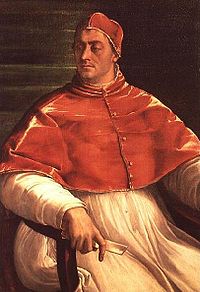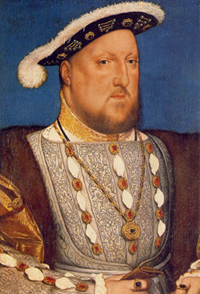
Second Italian War
Things turned around easily in Renaissance Europe. During the first Italian war, the Emperor Charles V was allied with the papacy and Britain against Francis I of France.When Pope Leon X died, his successor, Clement VII switched sides and supported France instead. The war ended when the French king was captured and was not released until he signed the Treaty of Madrid, which apparently he never intended to follow.
The League of the Cognac

Pope Clement VII had no love for the Hapsburgs, which is one of the reasons he had supported Francis against the emperor. But to the pope's chagrin, the French had lost and Italy was still teeming with Charles V's people. He could have given up, but with the prospect of gaining even more power, he was not ready to put his grudges to one side so soon (allegedly Pope Clement VII was exceedingly cruel).
Thus he began organizing an alliance to expel the Hapsburg powers (Spain and Sacred Roman Germanic Empire) from Italy. His first allies were the Republic of Venice and Francis I, who pretty much as soon as he got safely home announced he was to help Clement against Charles V and the high Spanish classes. They were also joined by Florence and by the House of Sforza who wanted the hegemony in Milan. They called the pact the League of the Cognac. At first, Britain refused to joint as Henry VIII wanted the pact signed in England, and nowhere else.
The War Begins
The League of the Cognac's forces moved quickly and took the municipality of Lodi. However, the Imperial troops were quick to respond (being a powerful king in those times also meant being surrounded by enemies, you had to be ready or you would be dead). His army moved to Lombardy and Sforza was forced to abandon their city, Milan. Once the soldiers were paid off they left.
Next, Charles V gathered an army of Landsknechte (European and German mercenary pikemen and supporting foot soldiers) commanded by Georg Frundsberg which included a considerable number of lutherans, on the one hand and of course, a Spanish army lead by Charles, Duke of Bourbon (Francis' old time enemy) on the other and advanced to Rome. The papal army, under Francesco Guicciardini's command could not offer proper resistance.
Apparently Charles failed to send enough money or provisions to supply the army with, and the soldiers only stayed and fought under the Duke of Bourbon's command under the promise of looting. So when the Duke was shot and killed during the battle, his armies sacked and looted, and burned and pillaged Rome without restraint. Pope Clement VII may have been powerful, but was far from brave – and withdrew at the first hint of danger. Charles was the winner and the League of the Cognac was no longer much of a threat.
The final battle and Andrea Doria's participation

The French received the news of the sack of Rome and the elimination of the pope's participation the war quite badly and rushed to strengthen their claims. On April 30, 1527, Henry VIII and Francis I signed the Treaty of Westminster, in which they agreed to mutually contribute against the emperor. Francis then sent a contingent under Odet de Foix and Pedro Navarro' command to Genoa -where Andrea Doria joined the French forces and took over most of the Genovese fleet- and then advanced to Naples, to prepare and get supplies for the siege of the city.
However, Francis owed Andrea Doria a lot of money, there were political intrigues against him in the French court and Francis demanded that he hand over Antonio Colonna and the Marquis of Vasto, who were Borgia's prisoners but whom Doria had excellent relationships with. The final stroke was that Andrea Doria had discovered that the French King was planning to appoint another Great Admiral in his place. Colonna and the Marquis tried to convince Doria to switch sides, and finally he heeded their words. After an interview with Charles V, he entered the Emperor's service, which earned him an intensive Spanish praise.
Meanwhile, the plague broke out in Genoa, sweeping away large numbers of the French forces that were besieging the city. Foix and Navarro themselves died. Andrea Doria's first action under Charles V was to break the siege around Genoa. The now feeble and weakened French forces surrendered.
The Genovese wanted to name him Dux, but Andrea rejected the title and accepted the one of Liberator et Pater Patriae (Liberator and Father of his Country) instead. Charles V appointed him as Great Admiral, Great Chancellor, Prince of Melfi and Marquis of Tursi.
Peace of Cambrai
Knowing that the war lost and there being no chance of ever recovering his position in Italy, and the war lost, Francis sought peace with Charles V. The terms of the peace agreement were pretty much those of the Treaty of Madrid, the one Francis had signed when prisoner in Madrid and broken at the first chance. Francis ceded his rights to Artois, Flanders and Tournai. To get his sons back he had to pay a ransom of two million golden écus. But there was one point in Francis’ favour. Since the Duke of Bourbon had died, there was no threat that he'd form his own independent kingdom of Provence.
The treaty was signed in August 5, 1529 and took France out of the war. Now only the Republic of Venice, Florence and the pope stood against Charles. But the Emperor was not idle, and soon after letting Francis go, travelled to Bologna, for an interview with the pope. They agreed that Clement VII would crown Charles and that he would absolve those responsible for the sack of Rome. In exchange, Charles gave him Ravenna and Cervia (they had been Venice' before, but the Republic had to surrender them, as well as Apulia). The Duke of Milan, Francesco II Sforza was allowed to returned to his city.
There was a further conflict between 1536 and 1538, when the Duke of Milan died. Francis invaded Italy, Charles invaded France. When peace was agreed, Turin remained in French hands, but in the grand scheme of renaissance Italy it mattered little. A curious anecdote about the peace negotiation was that Francis and Charles refused to share a room because of their mutual hatred, so Peter III had to act as mediator between the two monarchs, going from one room to the other, negotiating the Truce of Nice.
